Property Workshop is proudly reader-supported. When you buy through links on our site, we may earn a small Amazon affiliate commission but this does not affect the price you pay. Learn more here.
Woodworking routers are extremely versatile, but only professional cabinet makers and joiners know how to use them to their full potential. For example, most DIYers think routers are only useful for cutting grooves in wooden planks and chamfering shelving, but as I’ve discovered over the years, routers do so much more than that.
In this buying guide, I share my #1 router for 2024 after spending many hours rigorously testing and reviewing the UK’s best woodworking routers. I also share the key features to look for and what to avoid when shopping around.
Woodworking Router Reviews — The UK’s Top 3 in 2024
After many hours of research and testing, we recommend the Makita DRT50ZJX3. This 18V cordless router is excellent for keen DIYers and seasoned professionals alike.
The Makita DRT50ZJX3 router is an exceptionally versatile tool that works as a hand or plunge router. This versatility gives the DRT50ZJX3 an edge over its competitors in a close-run contest.
Read on for more details on each product we tested, starting with our worthy winner:
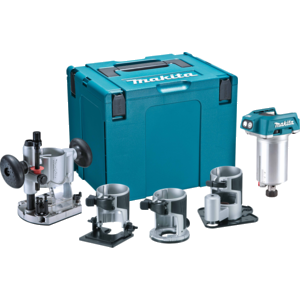
1. Makita DRT50ZJX3
- Powerful brushless motor
- Soft start function
- Variable speed control
- LED work light
- On/Off safety lock button
- Connects to dust extractor
- Aluminium base and housing
- Shaft lock
The Makita DRT50ZJX3 18V cordless router is an exceptional tool. Yes, it’s expensive, but you get what you pay for with this high-quality product.
The neatly designed MacPac case contains a host of goodies, including:
- Trimmer base
- Plunge base (this converts it into a plunge router)
- Offset base
- Dust extractor nozzle
- Two collets (3/8ʺ and ¼ʺ or 9.5 and 6.3mm)
- Various guides and templates
Unfortunately, this kit doesn’t include a battery or a charger, but you can share batteries if you already own other cordless Makita tools.
Pro Tip: Some adapters allow you to fit other manufacturers’ batteries.
This Makita router has a cutting depth capacity of 40mm when used as a trimmer and 35mm in plunge mode. You can change from trim mode to plunge mode by switching the base plate. The quick-release cam lock system makes this an easy job without requiring extra tools.
With a bare weight of 1.8kg, this Makita router is the lightest we reviewed, even when adding a 500g 4Ah battery.
The brushless motor runs much cooler than a carbon brush motor, meaning more energy goes into output power, making it more efficient and longer-lasting.
The 18V battery delivers variable speeds from 10,000 to 30,000 RPM, and the constant speed control maintains a pre-set speed under load. This feature is very useful when working with different materials.
It’s more expensive than the other models we reviewed, but its price is competitive compared to similar cordless routers. If cost isn’t a big concern, this is the router to purchase.
| Pros | Cons |
|---|---|
| The brushless motor is more efficient than carbon brushes. It’s also cooler in use and longer-lasting. | It’s expensive compared to the others we reviewed. |
| Lightweight, only 1.8kg without the battery. | No battery or charger is included. |
| As it’s battery-powered, you can use this router anywhere, and it takes batteries from the same Makita range. | |
| Variable speed of 10,000 to 30,000 RPM makes this the fastest router we tested. |
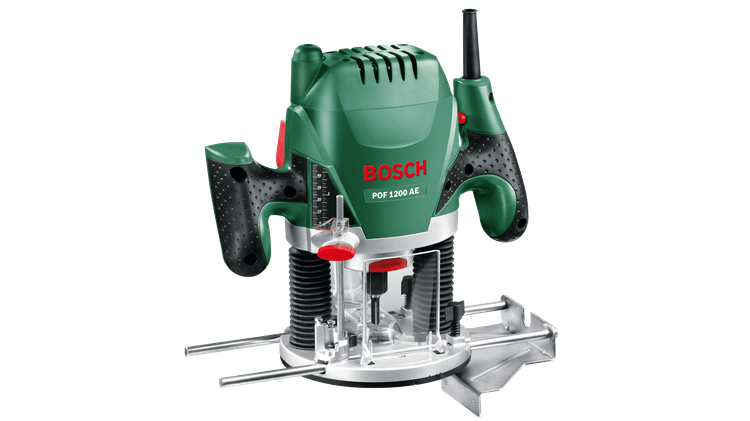
2. Bosch POF 1200 AE
- Great for routing grooves and edging profiles
- A parallel guide assists in milling precise grooves and circles
- Quick & easy bit changes through integrated spindle lock
- SDS for tool-free insertion of template guides
- Attaches to vacuum cleaners
The Bosch POF 1200 is a good option for the average DIYer, but it has a few undesirable features that make it less popular with professionals.
The first issue is the motor, which uses brushes — small electrical conductors rotating the shaft. As mentioned above, these motors are less efficient than brushless motors.
The second issue is the collet size. This router’s largest size is 8mm, but it’s supplied with a 6mm collet, limiting the types of jobs you can do straight out of the box.
It’s also noisy for its size. At 95 dBA, the operator must wear ear defenders when using it.
To give Bosch credit, they’re among the few manufacturers providing a true 640W output. So with a power input of 1,200W, this gives you a measure of the router’s efficiency, which in this case is 54%. While this efficiency isn’t great, the power output is more than enough for any DIY project you’re likely to encounter.
On the plus side, the Bosch POF 1200 has many redeeming features. Here are the most notable:
- The dust extraction port connects to any vacuum cleaner.
- Special Direct System (SDS) allows for quick insertion of template guides without additional tools.
- Integrated spindle lock for changing router bits quickly.
- A plunge depth of 55mm cuts through most wooden boards, including kitchen worktops (requires 8mm collet and bit).
- Lightweight at 3.4kg, considering the input power of 1,200W.
- Electronic speed control (ESC) for setting varying speeds from 11,000 to 28,000 RPM.
I’m a big fan of Bosch and own many of their tools. I like the look and feel of their products, and this model is no exception. I particularly like the soft and comfortable easy-grip handles.
| Pros | Cons |
|---|---|
| Lightweight for such a powerful tool. | The motor uses carbon brushes that may become worn over time. |
| Ergonomic design with soft grip handles. | Noisy — ear protection is essential. |
| Built-in dust extraction port for dust-free working. | It only comes with a 6mm collet, which makes it unsuitable for some heavy-duty jobs. |
| A plunge depth of 55mm makes it suitable for kitchen worktops, provided you fit an 8mm collet. | |
| Good range of preselected speeds to suit various materials. |

3. Silverline 264895
- Variable speed control with soft start function
- Adjustable plunge depth (0–50mm)
- 7-stage turret stop
- Parallel, roller and circle guides
- Includes 1/2”, 1/4”, 8mm and 12mm collets
- No load speed 6,000–26,000 RPM
- Includes guide bush and measurement bar
For such a low cost, this Silverline router packs a lot of high-end features.
This Silverline router easily cuts through worktops with a plunge depth of 50mm, making it a firm favourite with kitchen fitters.
The fine adjustment dial ensures the cut is accurate, and the 7-stage turret-stop allows you to graduate the depth of cut when using it as a plunge router.
The soft-start gives you total control over speed, which you can set anywhere between 6,000 and 26,000 RPM. This range is good enough for any job you’ll likely encounter around the home.
This Silverline router comes with four collets — 1/2″, 1/4″, 8mm, and 12mm — which is great if you already own bits in these sizes.
At 87 dBA, it’s relatively quiet, but I still recommend some form of ear protection if you’re using it for 15 minutes or more.
It weighs a little over 4kg, so it’s not too heavy to use as a hand tool, and the 1,500W motor provides more than enough power for most jobs.
In terms of accessories, the Silverline router comes with the following:
- 30mm guide plate
- Parallel, circle and roller guides
- Measurement bar
- Dust extraction attachment
These accessories provide an excellent starter kit if you’re new to routing.
| Pros | Cons |
|---|---|
| A plunge depth of 50mm makes it ideal for kitchen worktops. | The motor uses carbon brushes that may become worn over time. |
| Quieter and lighter than most corded routers. | |
| Includes four collets to suit a wide range of bit types and accessories. |
Best Woodworking Router — 2024 Comparison Table
| Product | Speed (RPM) | Power (V) | Weight (kg) | Cost | Rating out of 10 |
|---|---|---|---|---|---|
| Makita DRT50ZJX3 | 10,000 to 30,000 | 18 | 2.3 with battery | £££ | 9 |
| Bosch POF 1200 | 11,000 to 28,000 | 1,200 | 3.4 | ££ | 8.7 |
| Silverline 264895 | 6,000 to 26,000 | 1,500 | 4.1 | £ | 8.5 |
Woodworking Router Buying Guide
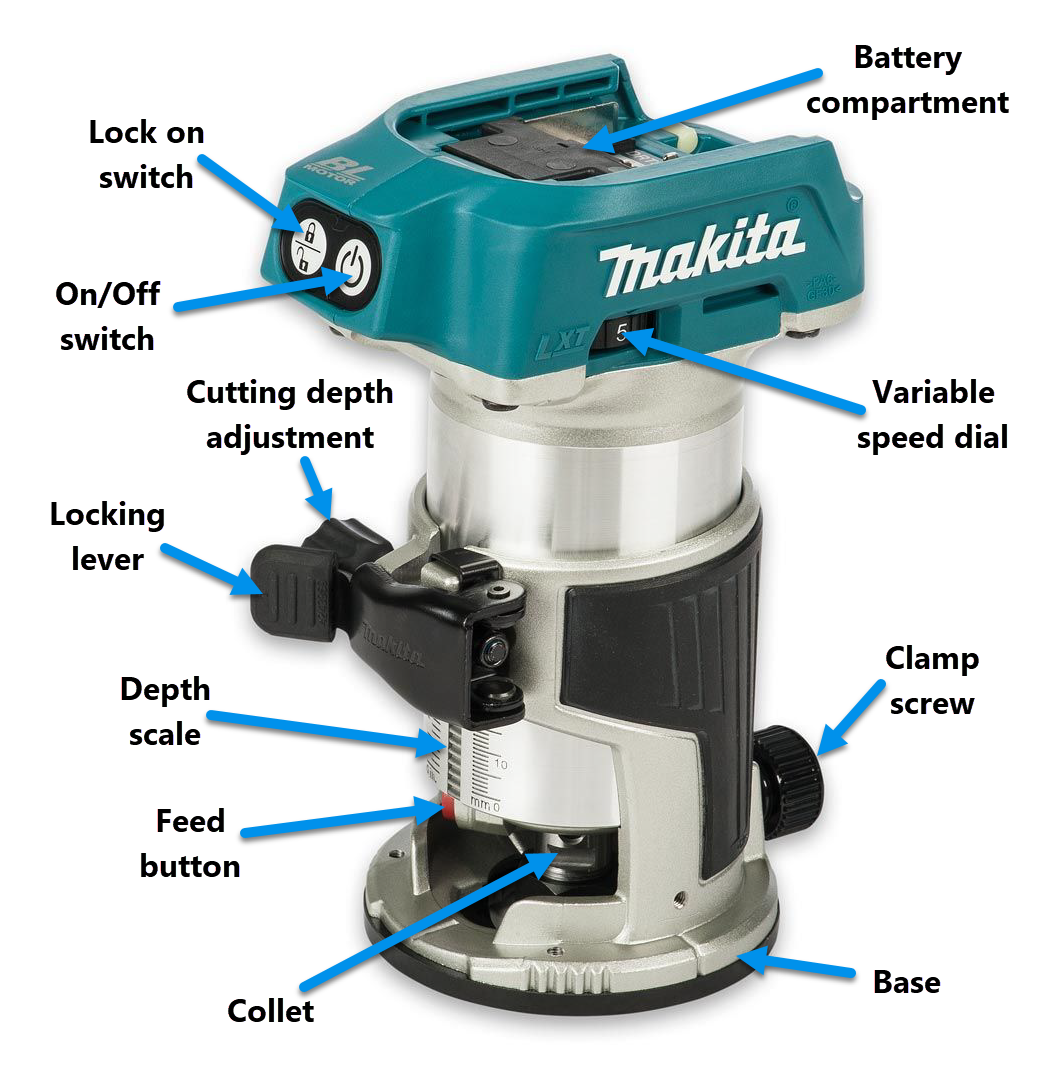
Below are the key features and points to consider when buying a woodworking router.
Collet
A collet is like a chuck on a drill. They come in several sizes, oddly in imperial and metric measurements.
The most common sizes are ¼”, ½”, 6mm, 8mm, and 12mm. The 6mm and 12mm roughly correlate to the ¼” and ½”, but not quite. So, if you have a set of imperial-sized bits, you may find they don’t fit the metric collet equivalent.
For heavy-duty work such as cutting through a worktop, where larger bits are necessary, the 12mm or ½” collets are best. The smaller collets work better at slower speeds and for detailed work.
Although collets are relatively inexpensive, a router with more than one collet saves you the trouble of buying others later, giving you more options from the start.
Power
Woodworking routers are corded or cordless, and the power measurement differs for each type.
Corded (240V Mains Supply)
Corded routers run off a 240V mains supply (stepped down to 110V on a building site), which generates much more power than any lithium-ion battery.
A corded tool’s power is rated in watts, and figures are usually marketed as power “output”. These figures can be misleading because the quoted number is really the power input, i.e., the amount of energy the tool uses. Power output can be as little as half this figure.
The energy isn’t lost. It simply transforms into less useful energy, such as heat and sound. Therefore, the power output will always be less than the power input unless the motor is silent and generates no heat. The ratio of input to output is a measure of the motor’s efficiency.
Pro Tip: You may see tools rated in horsepower (hp). As a simple guide, 1,500W is roughly equivalent to 2hp.
Cordless (Battery Powered)
If you want a cordless model, 18V is the highest power rating for most tools, although some batteries go as high as 36V.
An 18V battery with 4 amps running through it produces 72W of power (W = V x A).
However, battery power deteriorates between charges, and its capacity is rated in amp-hours (Ah). For example, a 4Ah battery provides 4 amps for one hour or 2 amps for two hours and so on…
Speed (no load)
A router’s speed is rated in RPM (revolutions per minute) and measured when free spinning, i.e. when the router is NOT applied to a piece of wood.
Speeds are usually variable and range from 0–6,000 RPM at the slow end to top speeds of 30,000 RPM.
The better models have a soft start feature, starting at zero and gradually increasing speed as you apply pressure on the trigger or adjust the setting wheel. As a safety feature, most routers come to a complete stop when you release the trigger.
Weight
Weight is an important consideration if you’re using the router by hand.
Some of the more powerful routers weigh in at a hefty 8kg, which is okay for table mount models but not for handheld models over long periods.
The lightest type of router is called a hand router, and the cordless variety can weigh as little as 2kg, including the battery.
Plunge Router vs. Hand Router
Plunge routers are best for cutting pieces of wood at 90⁰, although you can cut at other angles when using a tilting base plate.
Plunge routers are also called trim routers because they easily cut or trim boards and worktops. As such, they tend to be more powerful than hand routers.
As plunge routers can be handheld, some refer to the hand router as a palm router. Hand/Palm routers are commonly used for precise, detailed work where a plunge router is too cumbersome.
The maximum collet size on a hand router is usually 6mm or ¼ʺ, and a vast array of bits are available for engraving, chamfering, and profiling wood, plastic, or metal.
You can learn more about hand routers and their parts in this guide.
Other Considerations
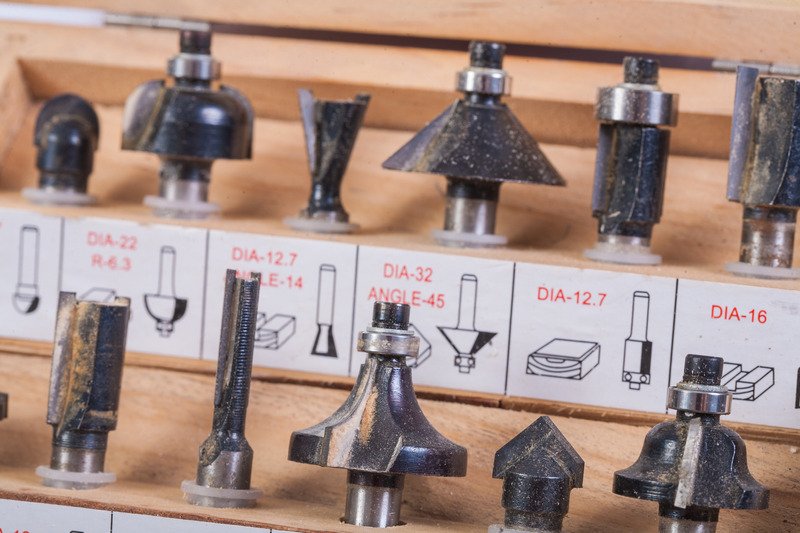
Below are some other factors to consider when buying a woodworking router.
Router Bits
We can’t look at routers without discussing bits. Router bits, like drill bits, have a shank and a bearing tip. The bearing tip is the business end of the bit, and these come in various shapes and sizes to suit your intended cut.
Almost anything is possible, from chamfering a piece of wood to cutting out a kitchen worktop for a sink. Bits can form simple rebates, ogee profiles, dovetail joints, coving, and V-grooves. And by combining bits, virtually any shape is achievable.
Bits are available in metric and imperial sizes, so you’ll see them as 12mm or ½ʺ, for example. Note that these are not the same! Although there’s not much difference (0.7mm, to be precise), you must buy router bits that match your router’s collet precisely.
You can learn more about bit profiles in this guide.
Depth of Cut
Also referred to as plunge depth, the depth of cut is the maximum material thickness the router can cut through.
The depth of cut may not be critical for mouldings because you can arrange the piece to allow cuts across the surface. However, you’ll need a cutting depth of around 50mm to cut through worktops.
Noise
Manufacturers aren’t very good at providing information on noise, so sometimes you have to search online to find it. Still, noise is a crucial factor to consider when buying a router.
Sound intensity is measured in decibels (dB), to which a weighting is applied (A, B, or C scales) to give a relative reading at differing frequencies. Routers and similar tools are measured using the A scale.
Distance from the source and the length of time you’re subjected to noise are other factors, but 70dBA is generally considered safe.
The trigger level where you must take precautions to avoid hearing damage is 85dBA, according to the Royal National Institute for Deaf People (RNID).
So, when you consider that routers can have a sound intensity approaching 100dBA, and you can’t distance yourself from the source, all you can do is limit exposure time and wear ear defenders.
Can excessive noise affect router performance? Yes, it can. Going back to the section on power, efficiency is the ratio of input over output, so the more energy converted to sound, the less efficient the motor.
Dust Extraction
As a router chops through wood, a lot of sawdust is generated. So, a router that is, or can be, fitted with a dust extractor is worth considering. This feature is essential if you’re frequently cutting worktops indoors, as these usually have a chipboard or MDF core.
Although worktops made in the UK and EU don’t contain a significant amount of formaldehyde (classified as carcinogenic by the HSE), other binders and sawdust are hazardous to your health if inhaled.
Accessories
When you purchase a woodworking router, check what comes in the box. Here are some useful accessories you might find:
- Adjustable tilting bases allow you to work at any angle to the workpiece.
- Router fence or edge guides for making channel cuts or to form a cut parallel to the opposite side of the piece.
- Additional collets for fitting various bit sizes.
Final Thoughts
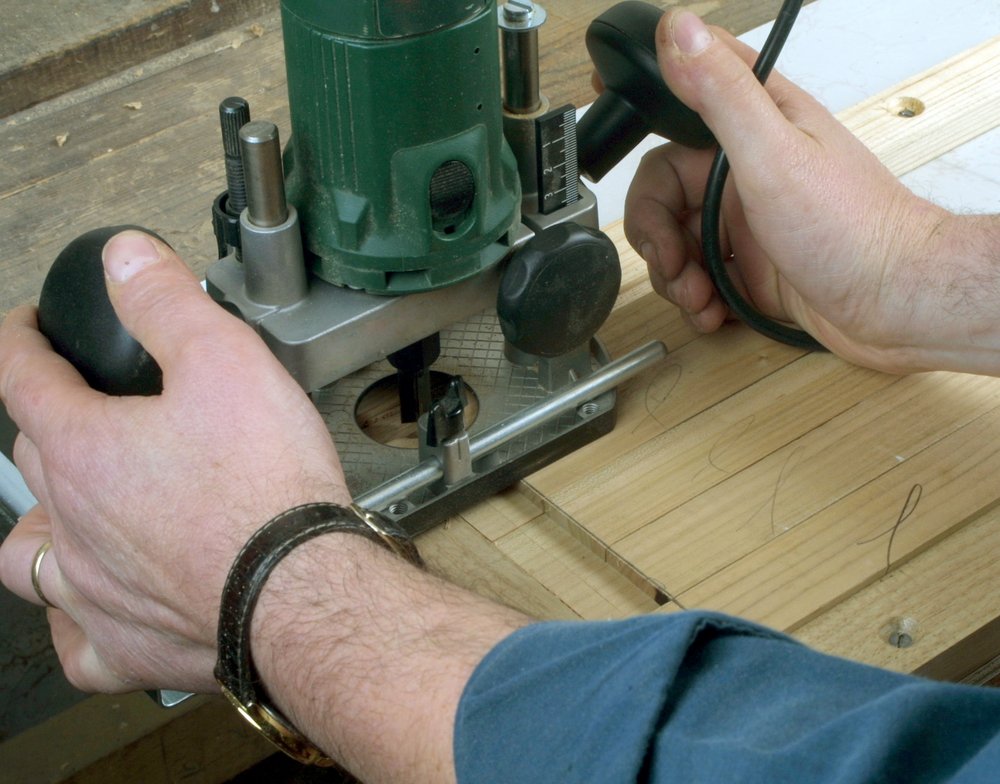
After many hours of testing and careful consideration, we firmly believe that the Makita DRT50ZJX3 is the best woodworking router on the UK market.
Due to the DRT50ZJX3’s efficient brushless motor, versatility and lightweight design, this router is an excellent choice for professionals and DIYers.
Pro Tip: Check out our router bit size guide if you plan to cut kitchen countertops.
FAQ
Below are answers to frequently asked questions about woodworking routers.
What is a good router for woodworking?
If you have a new kitchen to fit, a plunge router with a 12mm or ½ʺ collet does the trick.
A handheld/palm router is better for more precise, detailed work.
Which router tool is best?
We looked at the best woodworking routers for DIYers and professionals, and the Makita DRT50ZJX3 came out on top. We especially love its efficient brushless motor, versatility and lightweight design.
What’s the best budget wood router?
There are plenty of good routers at the budget end of the market. The Silverline 264895 faired well in our reviews, as did the Bosch POF 1200 AE.
There are cheaper routers, but you shouldn’t only think about cost. You’re far better off getting a good deal on a mid-range model like the Bosch POF 1200 AE than forking out £50 for something unsuitable.
Will a 12mm bit fit a half-inch collet?
A 12mm bit will NOT fit a half-inch collet.
The problem is with the shank. At 12mm, the bit is 0.7mm smaller than the ½ʺ collet. That may not seem much, but the collet won’t tighten against the bit shaft.
Always match the bit to the collet fitted to your router. Forcing it could damage the collet.
Can you connect an extraction port to any vacuum cleaner?
Any regular vacuum cleaner will connect to a router extraction port, but there are some things to consider before doing so.
First, sawdust generated by a woodworking router is very fine, so if your vacuum is fitted with a HEPA filter, it will soon block up, risking motor burnout.
Second, the hose from the vac to the router severely restricts movement. Ordinary vacs aren’t designed to be flexible enough to work with precision power tools like a router.
Wet and dry vacs are ideal for this job. As the name suggests, they can deal with dust and water, handy for spillages or flooding.
To see how wet and dry vacs work with routers and similar tools fitted with an extraction port, check out this video by Brighton Tools.
Is a battery-powered router better than a corded type?
Our top woodworking router in this buying guide is battery-powered, but that doesn’t necessarily mean cordless is the best option.
There are many advantages to using cordless routers, namely the freedom to work far away from a power socket.
However, a significant downside to cordless routers is having a dead battery before your work is complete. To avoid this, always have a fully charged spare battery on standby.
Corded tools are generally more powerful than cordless equivalents, but power is not everything. Factors like variable speed and collet size are also important.
Are routers noisy?
Yes, routers can be extremely noisy, over 100dBA in the worst cases.
As a general rule, 70dBA is considered acceptable, and 85dBA is the trigger level where precautions must be taken to prevent hearing damage.
Although often referred to as earplugs or ear defenders, hearing protection is more appropriate as a generic term. Different types of hearing protection fall into two categories — those inserted within the ear and those covering the ears (earmuffs).
The choice of hearing protection is personal, but for maximum safety and convenience, earmuffs are the best.
Can you use a router to form joints in wood?
Yes, you can use a router to form joints in wood.
Although virtually any joint is possible, some tools are better than others for a particular joint. Mitre joints, for example, are better formed using a tenon saw and mitre block, or you could use an electric mitre saw.
Routers are ideal for forming mortise and tenon joints with great precision using a straight bit. There are also special bits for dovetail joints.
Check out the Trend Knowledge Base for examples of joints formed using a router.
Can a wood router be used on other materials?
Yes, you can use routers on plastics, metal and glass.
When using a router on materials other than wood, it’s essential to have precise speed control and a range of bits that suit the material. Dust extraction is also recommended because inhaling small particles can be dangerous.
Solid tungsten carbide (STC) and the cheaper high-speed steel (HSS) router bits are usually used when cutting soft plastics such as polycarbonate and polyethylene or non-ferrous metals like aluminium, brass and copper. STC, in particular, keeps its sharpness for longer.
You can also use a router on ceramics and glass, but this is more of a specialist job because the rate at which the cutter is advanced against the workpiece must remain constant. For this purpose, you should use computer numerical control (CNC) routers with diamond-coated bits.
Who invented the woodworking router?
It’s hard to pinpoint when the electric router as we know it today was invented.
Like many great tools and machines, it developed over several years, with the first patent granted in 1908. George Kelley of the Kelley Electric Machine Company lodged the first patent in the US in 1906, and more followed soon after.

